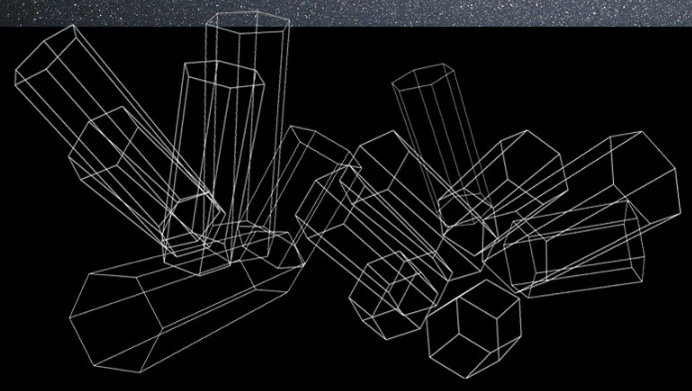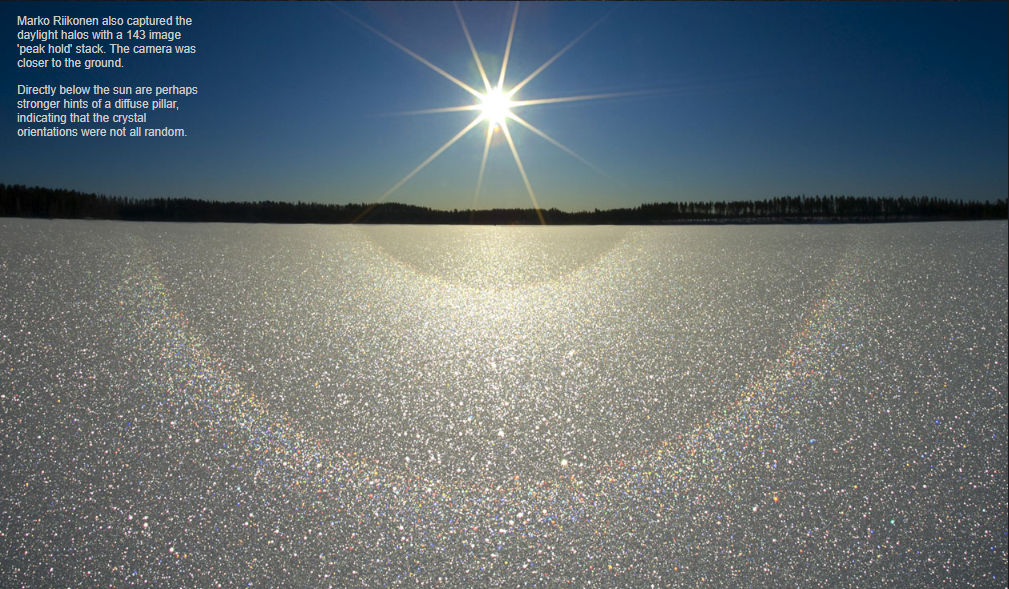OPOD - Ground Halos
OPOD - Ground Halos: A Captivating Display of Atmospheric Optics
When it comes to atmospheric optics, the phenomenon of ground halos presents a captivating visual display that often goes unnoticed. Recently, Jari Luomanen and Marko Riikonen managed to capture the beauty of ground halos in stunning photographs. These images showcase the glints of ice crystal gems on a frozen lake in Finland, creating a mesmerizing spectacle reminiscent of gemstones strewn across the surface.
Luomanen employed a unique technique by stacking 69 images to capture the full visual experience of ground halos. This approach was necessary due to the limitations of a camera, which has only one eye and remains stationary during exposure. Unlike humans, who constantly perceive myriad glints as they move by the surface crystals, the camera requires multiple photos to be stacked together to create a sum image. The resulting photograph reveals the intricate way light is scattered outside the halo rings, offering a dense field of crystals where the halos are seen with exceptional clarity.
The effects of thermal cycling, sublimation, recrystallization, and extra crystallization from humidity supplied by water on top of the lake ice play a significant role in shaping ground halos. These processes convert fallen snow crystals into larger and simpler forms of good optical quality. The hexagonal prisms lie tumbled in a more or less random orientation, ideally aligned to form the circular 22° and 46° halos. While the regular prisms appear on the left side of the photograph, those on the ground may be less uniform but still possess the same interfacial angles.
The formation of ground halos can be attributed to specific ray paths through the ice crystals. Rays passing between side faces inclined at 60° contribute to the formation of the 22° halo, while rays traversing a side face and a hexagonal end face form the 46° radius halo. Although the halos always appear circular to the naked eye or camera, the track of glinting crystals along the ground actually follows a hyperbola. This observation underscores the fact that these halos are not simply "rings" but rather represent the inner edges of glows that extend far beyond.
Even under moonlight, ground halos continue to captivate observers. In one photograph, a faint moon dog can be seen attempting to compete with the 22° ground halo, further highlighting the ethereal beauty of these optical phenomena. Marko Riikonen also captured the daylight halos using a 143-image "peak hold" stack, providing a closer perspective to the ground.
The presence of a diffuse pillar directly below the sun in Riikonen's photograph suggests that the crystal orientations within the ground halos were not entirely random. This observation adds an intriguing layer of complexity to the study of ground halos and underscores the importance of understanding the underlying mechanisms behind their formation.
In conclusion, ground halos represent a captivating and often overlooked aspect of atmospheric optics. The photographs captured by Jari Luomanen and Marko Riikonen offer a glimpse into the enchanting world of ice crystal gems on frozen lakes, forming intricate halos that mesmerize and intrigue. By delving deeper into the processes and characteristics of ground halos, we can gain a greater appreciation for the wonders of our natural environment and the complex interplay between light and ice crystals in the atmosphere.

Ground Halos ~ A frozen Finland lake glitters as if gemstone strewn. More at home in the skies, a 22� and rare 46� halo are formed from the glints of ice crystal gems on the lake surface. Jari Luomanen stacked 69 images to capture the visual impression.
�It was an insane day. A stacked image is the only way to approach and even surpass the visual experience. We humans have two eyes and we also tend to move around: our vision is constantly fed with myriad glints as we move by the surface crystals. The camera on the other hand only has one eye and is stationary during the exposure. Hence, it is necessary to combat this limitation by capturing numerous photos that are then stacked together as a sum image. Here the approach was taken quite far and the result is a dense field of crystals where the halos are seen very clearly. I especially like the way the photo reveals the way light is being scattered outside the halo rings.
The horizon and the sky were layered into the stack from the last shot of the series that was exposed without the sun blocking filter that is necessary to capture these kinds of photos.�
The effects of thermal cycling, sublimation, recrystallization and extra crystallization from humidity supplied by water on top of the lake ice convert fallen snow crystals into larger and simpler forms of good optical quality. These hexagonal prisms lie tumbled more or less randomly, ideally oriented to form the circular 22° and 46° halos. At left we see regular prisms, those on the ground are no doubt less regular but they still have the same interfacial angles.
Rays passing between side faces inclined 60° form the 22° halo. Rays traversing a side face and an hexagonal end face – refraction through a 90° prism – make the 46° radius halo.
To the eye or camera the halos always look circular. However, the track of the glinting crystals along the ground is a hyperbola. The glints show nicely that these halos are not 'rings'. 22° and 46° are only mark the inner edges of glows that extend far beyond.

The scene by moonlight. A faint moon dog tries to compete with the 22° ground halo.

Marko Riikonen also captured the daylight halos with a 143 image 'peak hold' stack. The camera was closer to the ground.
Directly below the sun are perhaps stronger hints of a diffuse pillar, indicating that the crystal orientations were not all random.

Note: this article has been automatically converted from the old site and may not appear as intended. You can find the original article here.
Reference Atmospheric Optics
If you use any of the definitions, information, or data presented on Atmospheric Optics, please copy the link or reference below to properly credit us as the reference source. Thank you!
-
<a href="https://atoptics.co.uk/blog/opod-ground-halos/">OPOD - Ground Halos</a>
-
"OPOD - Ground Halos". Atmospheric Optics. Accessed on November 21, 2024. https://atoptics.co.uk/blog/opod-ground-halos/.
-
"OPOD - Ground Halos". Atmospheric Optics, https://atoptics.co.uk/blog/opod-ground-halos/. Accessed 21 November, 2024
-
OPOD - Ground Halos. Atmospheric Optics. Retrieved from https://atoptics.co.uk/blog/opod-ground-halos/.